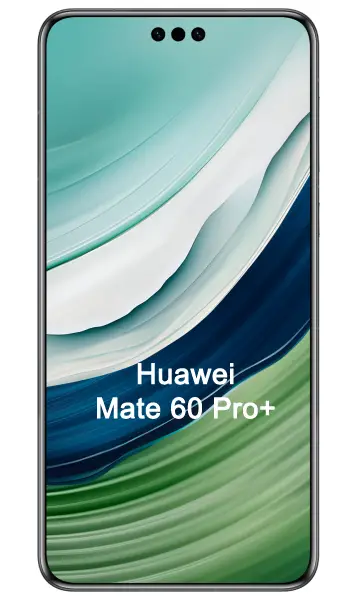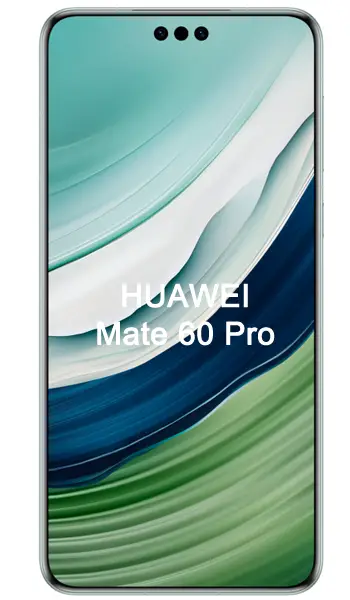Huawei Mate 60 Pro+ vs Huawei Mate 60 Pro Comparison and Differences
Smartphone 1

Huawei Mate 60 Pro+
Smartphone 2

Huawei Mate 60 Pro
Smartphone 3
Differences between Huawei Mate 60 Pro+ and Huawei Mate 60 Pro - Which to Choose?
Reasons to consider the Huawei Mate 60 Pro+:
- Better RAM capacity with options including 512GB 16GB RAM and 1TB 16GB RAM, compared to the Mate 60 Pro's maximum of 1TB 12GB RAM.
- Higher camera resolution with a 48 MP ultrawide sensor versus the Mate 60 Pro's 12 MP.
- Includes DXOMARK scores: 157 (DXOMARK Mobile), 160 (Photo), and 148 (Video).
Reasons to consider the Huawei Mate 60 Pro:
- Lower starting price at 890 EUR.
- More color options are available: Black, White, Green, and Purple.
- Marginally higher AnTuTu 9 benchmark score of 769211 compared to the Mate 60 Pro+'s score of 768887.
- Higher score in Geekbench 5 multi-core with 3897 points, compared to the Mate 60 Pro+'s not listed data.
Both phones feature 5G connectivity, similar battery capacities with fast charging support, octa-core Kirin 9000S processors, and HarmonyOS 4.0, offering similar performance foundations. The choice between the two may come down to the prioritization of camera quality and RAM capacity versus price and color variety.
Huawei Mate 60 Pro+ or Huawei Mate 60 Pro Specs Comparison
or
 Common specs
Common specs
| Brand and model | Huawei Mate 60 Pro+ | Huawei Mate 60 Pro | |
| Rating | (+0) | (+0) | |
| Release date | 2023, September 08 | 2023, August 29 | |
| Dimensions (HxWxD) | 163.7 x 79 x 8.1 mm | 6.44 x 6.44 x 3.11 in | 163.7 x 79 x 8.1 mm | 6.44 x 6.44 x 3.11 in | |
| Weight | 225 g | 7.94 oz | 225 g | 7.94 oz | |
| Body Build | Glass front, aluminum frame, glass back | Glass front, aluminum frame, glass back | |
| Case | buy from Amazon | buy from Amazon | |
| Colors | Black, Light Gold | Black, White, Green, Purple | |
| Battery | 5000 mAh, Li-Po, non-removable | 5000 mAh, Li-Po, non-removable | |
| Approximate price | 890 EUR | ||
| Check price | from Amazon | from Amazon |
 Screen
Screen
| Technology | LTPO OLED | LTPO OLED | |
| Touchscreen | capacitive touchscreen | capacitive touchscreen | |
| Display colors | 1B | 1B | |
| Screen size | 6.82" in | 6.82" in | |
| Screen area | 114.4 cm2 | 114.4 cm2 | |
| Screen format | 19.5:9 (height:width) | 19.5:9 (height:width) | |
| Screen to body ratio | 88.5% | 88.5% | |
| Screen resolution | 1260 x 2720 px | 1260 x 2720 px | |
| Screen PPI /points per inch/ | 440 PPI | 440 PPI | |
| Screen protection | Huawei Kunlun Glass 2 | Huawei Kunlun Glass 2 | |
| Other specs | - 120Hz - |
- 120Hz | |
| Screen protector | buy from Amazon | buy from Amazon |
 Camera and Video
Camera and Video
| Rear camera, main | 48 MP, Triple | 50 MP, Triple | |
| Camera specs | -48 MP, f/1.4-f/4.0, 24mm (wide), PDAF, Laser AF, OIS -48 MP, f/3.0, 90mm (periscope telephoto), PDAF, OIS, 3.5x optical zoom -40 MP, f/2.2, 13mm, 120˚ (ultrawide), PDAF |
-50 MP, f/1.4-f/4.0, 24mm (wide), PDAF, Laser AF, OIS -48 MP, f/3.5, 90mm (periscope telephoto), PDAF, OIS, 3.5x optical zoom -12 MP, f/2.2, 13mm, 120˚ (ultrawide), PDAF |
|
| Functions | LED flash, panorama, HDR | LED flash, panorama, HDR | |
| Video | 4K@30/60fps, 1080p@30/60/120/240/480fps, 720p@960fps, 720p@3840fps, HDR, gyro-EIS | 4K@30/60fps, 1080p@30/60/120/240/480fps, 720p@960fps, 720p@3840fps, HDR, gyro-EIS | |
| DxOMark Main Score | 157 | ||
| DxOMark Photo | 160 | ||
| DxOMark Video | 148 | ||
| Front camera, selfie | 13 MP, Single | 13 MP, Single | |
| Specifications | 13 MP, f/2.4, 18mm (ultrawide) TOF 3D, (depth/biometrics sensor) |
13 MP, f/2.4, 18mm (ultrawide) TOF 3D, (depth/biometrics sensor) |
|
| Functions | HDR, panorama | HDR, panorama | |
| Video | 4K@30/60fps, 1080p@30/60/240fps | 4K@30/60fps, 1080p@30/60/240fps |
 Performance
Performance
| Operating system - OS | HarmonyOS 4.0 (China) | HarmonyOS 4.0 (China) | |
| Chipset | - Kirin 9000S (7 nm) | - Kirin 9000S (7 nm) | |
| CPU | - Octa-core (1x2.62 GHz Taishan Big & 3x2.15 GHz Taishan Mid & 4x1.53GHz Cortex-A510) | - Octa-core (1x2.62 GHz Taishan Big & 3x2.15 GHz Taishan Mid & 4x1.53GHz Cortex-A510) | |
| GPU | Maleoon 910 MP4 | Maleoon 910 MP4 | |
| External memory | NM (Nano Memory), up to 256GB (uses shared SIM slot) | NM (Nano Memory), up to 256GB (uses shared SIM slot) | |
| Internal memory | 512GB 16GB RAM, 1TB 16GB RAM | 256GB 12GB RAM, 512GB 12GB RAM, 1TB 12GB RAM |
 Benchmark
Benchmark
| Antutu 9 Total | 768887 | 769211 | |
| GeekBench 6 Single Core | 1218 | ||
| GeekBench 6 Multi Core | 3282 | ||
| GeekBench 5 Single Core | 1044 | ||
| GeekBench 5 Multi-Core | 3897 |
 Communication and Connectivity
Communication and Connectivity
| SIM card | Hybrid Dual SIM (Nano-SIM, dual stand-by) | Hybrid Dual SIM (Nano-SIM, dual stand-by) | |
| Network | GSM / CDMA / HSPA / CDMA2000 / LTE / 5G | GSM / CDMA / HSPA / CDMA2000 / LTE / 5G | |
| Bands | -2G - GSM 850 / 900 / 1800 / 1900 - SIM 1 & SIM 2 CDMA 800 -3G - HSDPA 800 / 850 / 900 / 1700(AWS) / 1900 / 2100 CDMA2000 1x -4G - LTE -5G - SA/NSA |
-2G - GSM 850 / 900 / 1800 / 1900 - SIM 1 & SIM 2 CDMA 800 -3G - HSDPA 800 / 850 / 900 / 1700(AWS) / 1900 / 2100 CDMA2000 1x -4G - LTE -5G - SA/NSA |
|
| Speed | HSPA, LTE-A, 5G | HSPA, LTE-A, 5G | |
| GPRS | Yes | Yes | |
| Edge | Yes | Yes | |
| Wi-Fi | Wi-Fi 802.11 a/b/g/n/ac/6, dual-band, Wi-Fi Direct | Wi-Fi 802.11 a/b/g/n/ac/6, dual-band, Wi-Fi Direct | |
| GPS | GPS (L1+L5), GLONASS (L1), BDS (B1I+B1c+B2a+B2b), GALILEO (E1+E5a+E5b), QZSS (L1+L5), NavIC (L5) | GPS (L1+L5), GLONASS (L1), BDS (B1I+B1c+B2a+B2b), GALILEO (E1+E5a+E5b), QZSS (L1+L5), NavIC (L5) | |
| NFC | Yes | Yes | |
| USB | USB Type-C 3.1, OTG, DisplayPort 1.2 | USB Type-C 3.1, OTG, DisplayPort 1.2 | |
| Bluetooth | 5.2, A2DP, LE | 5.2, A2DP, LE |
 Music and Audio
Music and Audio
| Radio | No | No | |
| Headphone jack | No | No | |
| Others | - 32-bit/384kHz audio | - 32-bit/384kHz audio |
 Other features
Other features
| Sensors | - Face ID, fingerprint (under display, optical), accelerometer, gyro, proximity, barometer, compass, color spectrum , Infrared port | - Face ID, fingerprint (under display, optical), accelerometer, gyro, proximity, barometer, compass, color spectrum , Infrared port | |
| Other extras |
- BDS Satellite Calling and Message - 88W Fast charging, 100% in 30 min -50W Wireless charging -20W Reverse wireless charging - IP68 dust/water resistant (up to 6m for 30 min) |
- BDS Satellite Calling and Message - 88W Fast charging, 100% in 30 min -50W Wireless charging -20W Reverse wireless charging - IP68 dust/water resistant (up to 6m for 30 min) |
|
| Versions |
- Also known as Huawei Mate 60 Pro Plus |
Reviews and Opinions on Huawei Mate 60 Pro+ and Huawei Mate 60 Pro
If you had to recommend one of these phones to a friend, which one would it be and why? Share your arguments using the Add Opinion button!

